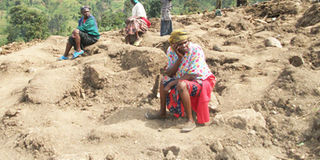Prime
Bududa Survivors still hope to bury their relatives a month after landslide

RELATIVE’S GRIEF: Ms Nabulo (R) and other survivors at the scene of the March 1 landslide. PHOTO DAVID MAFABI
Although majority of the survivors from Nametsi village and the surrounding ridges prone to landslides have relocated to a temporary camp at Bulucheke Sub-county headquarters, Ms Agatha Nabulo is yet to make the move.
Ms Nabulo, who lost her entire family of 16 in the March 1 disaster, is refusing to leave Nametsi until all the bodies of her relatives are retrieved and given a decent burial.
She is not alone; there are about 20 other survivors who have stayed at the ruins where between 250 and 350 people are believed to be still buried underneath.
Every morning they look up to the skies, let their eyes dart around the vast waste hoping for some miracle to dig up their loved ones buried under tonnes of rock and soil.
Promised help of large earth moving equipment and a presidential directive that everyone buried under must be retrieved and accounted for are yet to materialise.
“I only go to Bulucheke to get food and I come back here, look through this place every day hoping to find my dead relatives,” Ms Nabulo said last week.
“I know they are dead now but it is important in our tradition to get the remains whether bones or even ash and give a decent burial in order not to be attacked by spirits.”
Waiting for miracles
Ms Nalubo says she understands the difficulties in retrieving the bodies and more so identifying people buried now for more than 30 days, but she is still holding onto the hope of a miracle.
Many others are waiting too, especially after reports that the United Nations Mission in Congo (Monuc) is to help airlift earth movers to the site.
“We were told the UN was coming with big helicopters (carrying bulldozers) to start exhuming the bodies but we are still waiting,” says Mr Michael Natseli who also lost three children and a wife.
Although the ground leveling to pave way for a landing pad is complete, a helicopter from the UN last month only came, hovered around the ridges and went back without any sign that they would come back with the promised equipment.
The national director for emergence coordination and operation in the Office of the Prime Minister, Maj. Gen. Julius Oketta, however, says there is a lot of technological aspects supposed to be considered before airlifting of equipment to the site.
He revealed that the hovering of the helicopter at the ridges was meant to make final surveillance, take the coordinates and determine the weather changes in the area before landing can be effected.
“We expect them (Monuc) anytime from now because the UN and the government have now taken over exhuming of the bodies,” Gen. Oketta said.
He said once the bodies are exhumed, chance will be given to the locals to identify relatives and the remaining shall be buried in a mass grave. A national day of mourning would be declared and a monument in memory of those killed is to be built.
Activity at the scene of devastation has since gone silent but the shock is still clear. Instead, the place has turned into a sort of pilgrimage where relatives and other survivors return every morning, huddle in groups and still talk in low tones.
No more
Except for remnants of iron sheets; wattle, stones, brick, a few remains of the clothes in the gardens and other debris scattered, everything has been buried; the surroundings looks abandoned.
Bududa District chairman Wilson Watira is siding with the survivors, maintaining hope that every individual will be accorded a descent burial. “My people are still buried under the rubble. The only thing I need is to have them exhumed to be given a decent burial,” he told Daily Monitor over the weekend.
“This is what everyone is craving for and if Monuc does not come, we shall continue with our local efforts to have the bodies exhumed.” But for locals like Ms Nabulo, time is a slow healer and only a decent burial for lost relatives will exorcise the ghosts of the tragedy.



